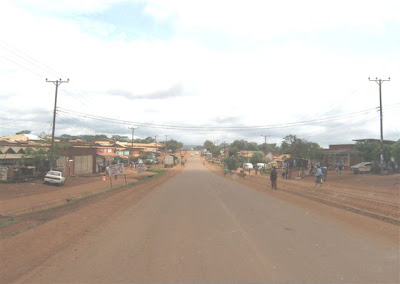You have to pass through the town of Karatu, above, to reach the Ngorongoro Crater/Conservation Area
I have so many photos of our recent safari to the Ngorongoro Crater - and it is just such a magnificent place - that I couldn’t possibly squeeze it all in to one or even two posts – so our recent visit there is going to be covered over 3 posts, with today’s post being ‘Part 1’. ‘Part 2’ will then publish on Monday and ‘Part 3’ will publish on Wednesday.
Then on Friday .… oooohhhh ….. well, I have something very special lined up for all you lovely people on Friday ;) which will tie in with these 3 posts on the Ngorongoro Crater - something I’ve never done on the blog before, and something which I hope you will all enjoy and be able to participate in. So, watch this space ! But in the meantime (if you can bear the suspense ! the excitement !) …. back to our recent safari ………….. the photo’s in this post show you the road’s you take to get to the Crater.
Then on Friday .… oooohhhh ….. well, I have something very special lined up for all you lovely people on Friday ;) which will tie in with these 3 posts on the Ngorongoro Crater - something I’ve never done on the blog before, and something which I hope you will all enjoy and be able to participate in. So, watch this space ! But in the meantime (if you can bear the suspense ! the excitement !) …. back to our recent safari ………….. the photo’s in this post show you the road’s you take to get to the Crater.
Shops along the roadside in the town of Karatu
The Ngorongoro Crater has not only been declared a ‘World Heritage Site’ (and is referred to by many as ‘The 8th Wonder Of The World”) but is also the largest Caldera in the world – basically, it was once (around 2 – 3 million years ago !) a volcano which erupted and collapsed in on itself. You could think of it as a large ‘basin’ with a dense concentration of wildlife inside it. It is around 260 square kilometers (100 square miles) in size and lies within the Ngorongoro Conservation Area (‘NCA’) which totals around 8 280 square kilometers (3196 square miles) in size. That’s pretty big – Tanzania is such a vast country !
Inside the Ngorongoro Conservation Area, the deep rust coloured earth of the narrow roads contrasts with the lush green of the surrounding vegetation
The NCA borders the Serengeti National Park (which, incidentally, was my home for some time several years ago as my husband & I both lived/worked within the Park !), and also includes the world famous archaeological site, Olduvai Gorge – which is considered to be the ‘Cradle of Humankind’ - it contains hominoid footprints dating back some 3,5 million years aswell as the earliest known specimens of early hominids ‘Paranthropus Boisei’ and the human genus ‘Homo Habilis’. (We did not visit Olduvai Gorge this time, but have in the past – and it is quite an incredible place, and well worth the visit – especially if you are en route to the Serengeti National Park).
Dense, lush vegetation surrounds you as you climb higher and higher towards the magnificent Ngorongoro Crater ....
The NCA is unique in that it allows human habitation – livestock, humans (which include some 42 000 Maasai) and protected wildlife (25 000 – including the ‘big 5’ – Lion, Leopard, Elephant, Black Rhinoceros and Buffalo) all living side-by-side. The Maasai are allowed to take their livestock in to the Crater to graze/drink water, but are not allowed to live in or cultivate crops in the Crater itself.
 Situated on the rim of the Ngorongoro Crater, the Ngorongoro Serena Safari Lodge (where we stayed) is built of stone - with wooden decks and stairs connecting the main areas - and blends well into the surrounding countryside
Situated on the rim of the Ngorongoro Crater, the Ngorongoro Serena Safari Lodge (where we stayed) is built of stone - with wooden decks and stairs connecting the main areas - and blends well into the surrounding countryside
There are several hotels, lodges and camp sites situated along the rim of the Crater where you can stay when you are visiting, and in my next post I’ll be showing you inside the lovely lodge which we stayed in during our recent safari !
 Situated on the rim of the Ngorongoro Crater, the Ngorongoro Serena Safari Lodge (where we stayed) is built of stone - with wooden decks and stairs connecting the main areas - and blends well into the surrounding countryside
Situated on the rim of the Ngorongoro Crater, the Ngorongoro Serena Safari Lodge (where we stayed) is built of stone - with wooden decks and stairs connecting the main areas - and blends well into the surrounding countryside There are several hotels, lodges and camp sites situated along the rim of the Crater where you can stay when you are visiting, and in my next post I’ll be showing you inside the lovely lodge which we stayed in during our recent safari !




